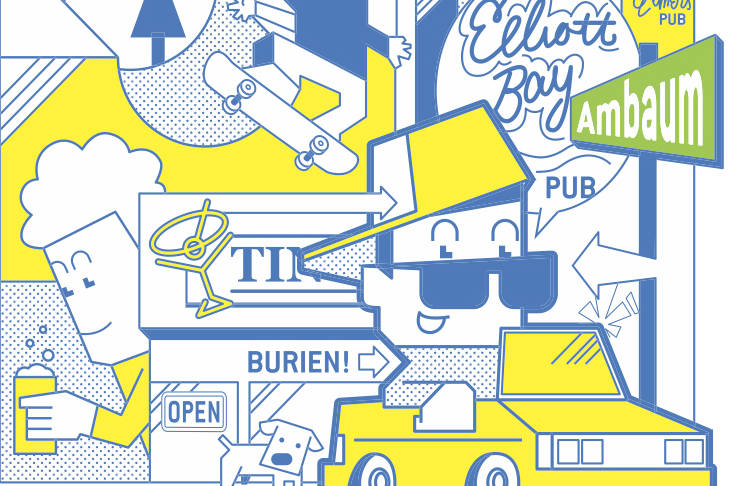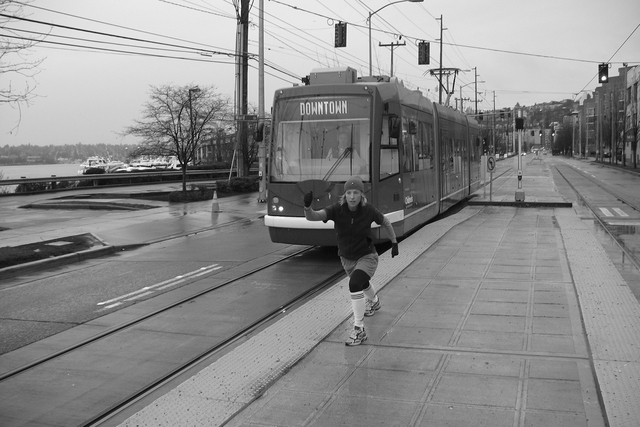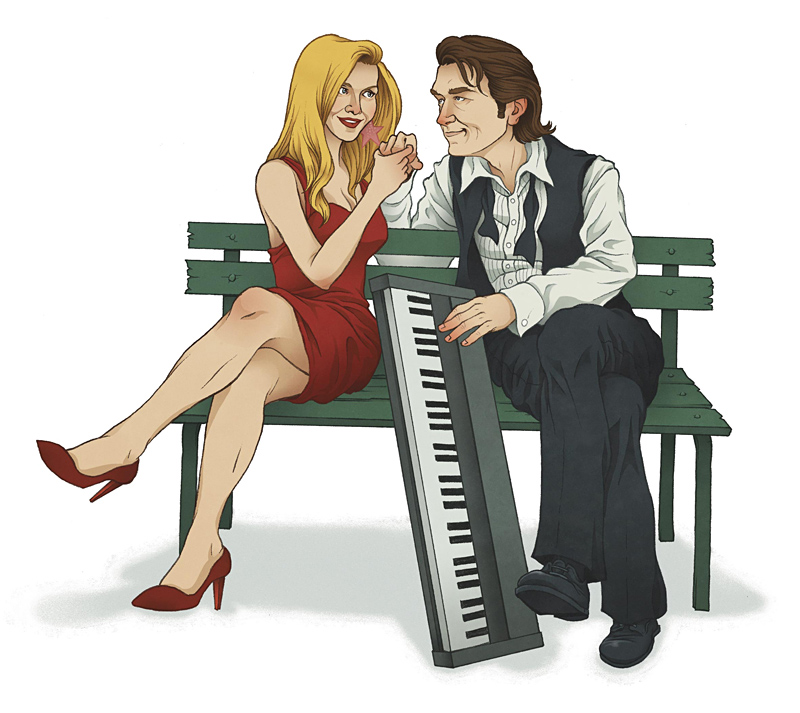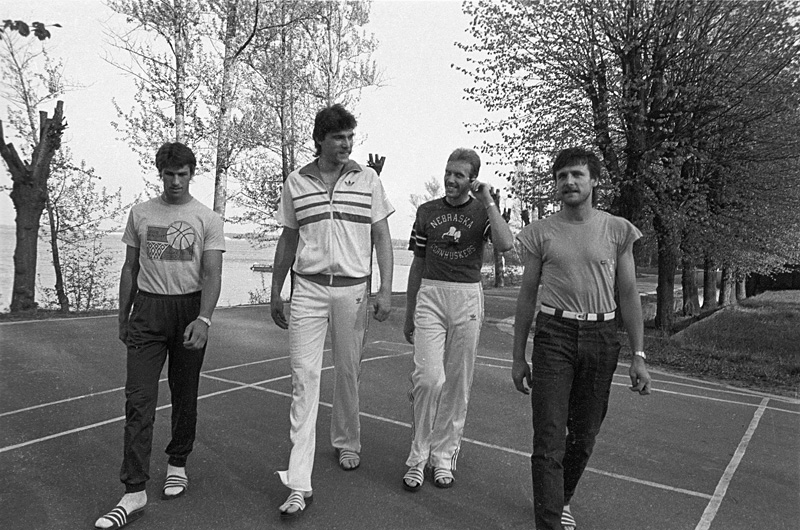The sun had yet to rise as I waited for the Pancake Chef in SeaTac to open on a Saturday in 2009. I’d just dropped off my wife at the airport, and had stopped at one of the last nostalgic-Americana holdovers in an area nicknamed Little Mogadishu for its swelling Somali population.
A waitress unlocked the door at 6 a.m. Entering the restaurant in front of me were three men well past working age. They didn’t have to order coffee when they sat down; the waitress just poured it for them. They didn’t have to order food, either; she knew what they desired. This was their everyday ritual, their perch from which to pontificate on the local goings-on.
“It’s a big day for Burien,” one of them remarked, providing no context. He didn’t have to: His breakfast comrades knew intrinsically that today was the grand opening of Burien Town Square, a mixed residential/retail/civic (new public library and City Hall) center that was to cement the rise of a southwesterly Seattle suburb that some pundits had breathlessly referred to as the Brooklyn of Seattle.
The dynamic was specious, however. America was in the midst of a mortgage crisis, and the Seattle area’s bubble was finally bursting, albeit far later than in most parts of the country. What was to have been a big day for Burien turned out to be an embarrassing one: Burien Town Square sat virtually empty for years, quickly heading into foreclosure and changing hands multiple times, a glowering example of opulent optimism run aground.
Eight years later, all of Burien Town Square’s condominiums have been sold, with its ground-floor retail finally filling in as new edifices rise around it. A PCC and Bakery Nouveau are set to open nearby, and a stylish restaurant in Old Burien features a subterranean cinema where you can specify how frequently you want a fresh Manhattan to arrive at your seat as indie flicks like The Lobster and Paterson are projected onto a small screen. Boutiques, gourmet ice creameries, wine bistros, and a coffee shop (Burien Press) that wouldn’t feel out of place in Los Angeles’ Silver Lake neighborhood are balanced by harbingers of old Seattle like Vince’s, Round Table Pizza, and Azteca (a chain that was started in Burien); a model train store; an auto row on First Avenue South; an unironically divey Chinese lounge (Wah Kue) that shows Family Feud even when huge sporting events are occurring in real time; a big, old bowling alley; and a 911 Supply shop that specializes in gear designed for cops and firefighters.
Burien humbly weathered its storm, and is kind of perfect now—the ideal synthesis of old and new Seattle for longtime residents who lament what’s become of Ballard.
If you parachuted a Seattleite who’d never left the city limits into Burien, she’d find it to be at least passively familiar. There’s an Elliott Bay Brewery, a Grand Central Bakery, a Smarty Pants, an Ola Salon, and The Point, the sister sports bar of West Seattle’s popular Bridge.
“It reminds me a lot of old West Seattle, like before all the condos went in,” says Bridge and Point owner Rita Dixson, who opened the latter establishment in downtown Burien a year ago. “It’s just a charming neighborhood with a lot of growth happening.”
Four blocks north of this hullabaloo, in a Nordic building that looks like it’s been airlifted from Leavenworth, is Hans’ German Sausage & Delicatessen. Its neighbor is the Sidestreet Kitchen and Bar, boasting a dark, understated aesthetic that’s as inconspicuous as its name. Conceived as a wine bar and dinner house, the Sidestreet had to shift its ambitions even before it opened in 2008, as owner Dan Davis was well aware that the economy was cratering. Unlike Burien Town Square, he had an opportunity to audible, and did.
“I had a good friend who’d been a longtime bartender at McCormick & Schmick’s,” explains Davis, a native Burienite who can hear the bells of his old elementary school ring when he parks his black Chevy Tahoe at the Sidestreet each morning. “He looked at the space with fresh eyes and realized we needed a bar.” Despite the repositioning, Davis concedes that business “was touch-and-go for a minute,” adding, “I figured if I could make it in that situation, it would be good for this place’s longevity.”
Davis persevered, and through well-warranted word of mouth, he’s built a strong happy-hour following—cheap, buttery bowls of rosemary popcorn and killer $5 burgers help—backed by a multigenerational dinner crowd that knows full well it’s stumbled into a diamond in the rough. It’s the sort of place where neighbors bump into each other over plates of fried chicken and Nutella cheesecake, or where Highline High School teachers unwind with a glass of wine or a stiff martini after a day spent enriching the minds—and putting up with the bullshit—of mega-hormonal teens.
My workday begins at 5 a.m., which I bring up only to make the point that I feel like slightly less of a loser when I order a pint of Rainier at 2 p.m., as I did on a recent Thursday at The Hobnobber, a long-in-the-tooth tavern located a block south of downtown Burien’s main drag.
“Don’t snob, hobnob,” reads a sign affixed to a wall of pull tabs, as the first round of the PGA’s Dean & DeLuca Open plays on two television sets overhead. Two regulars get to talking about the sort of things you’re prone to purchase on a Costco run, with toilet paper being a perennial. This leads one of the men to remark, “Isn’t it funny how your toilet paper purchase directly corresponds with your beer purchase: The cheaper the beer you buy, the more expensive the toilet paper.” (The next round of Pabst Brown Ribbon’s on him.)
After my beer, I embark upon an epic walk through Burien’s Seahurst neighborhood, perched high above Puget Sound. As I descend toward the shores of Seahurst Park, I pass a woman walking not a dog, but a pot-bellied pig, and am struck by the lack of dandelions in the lawns of the regal homes that surround us.
Upon reaching the ocean, I ascend a wooded trail, passing unleashed dogs and their owners on makeshift bridges that cross over creeks. Navigating a multitude of switchbacks and peering down at the ocean, I get pleasingly lost, clueless as to where I’ll end up when the trail ends—or if the trail will ever end at all.
I begin to question whether Burien really wants me to leave, and whether I really want to leave Burien.
news@seattleweekly.com








